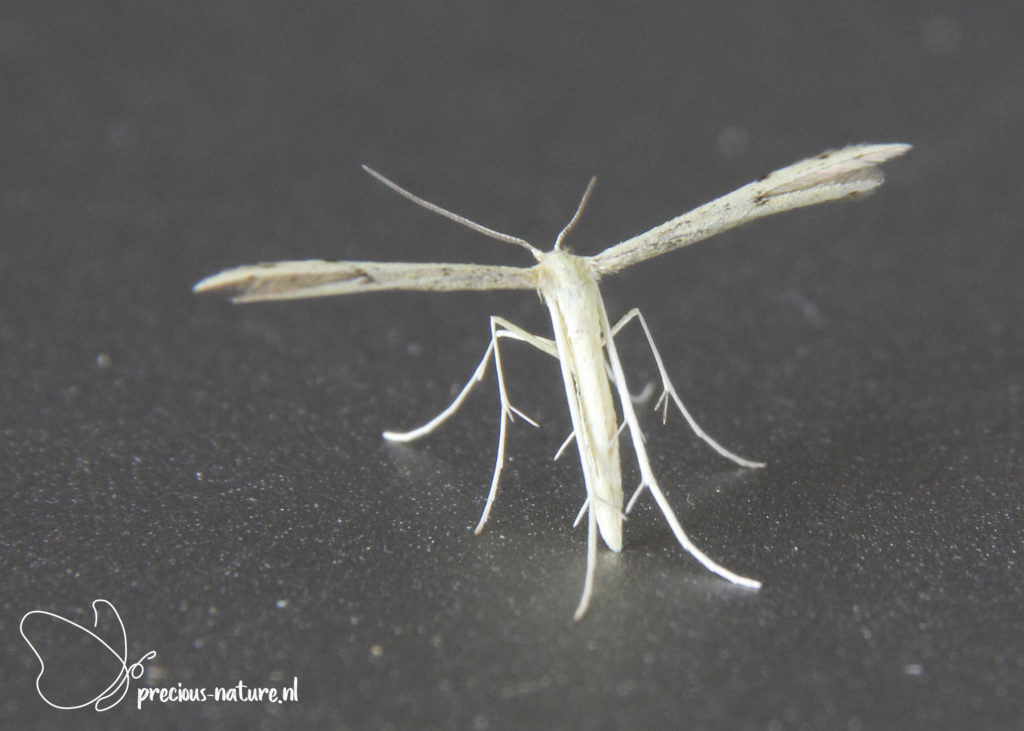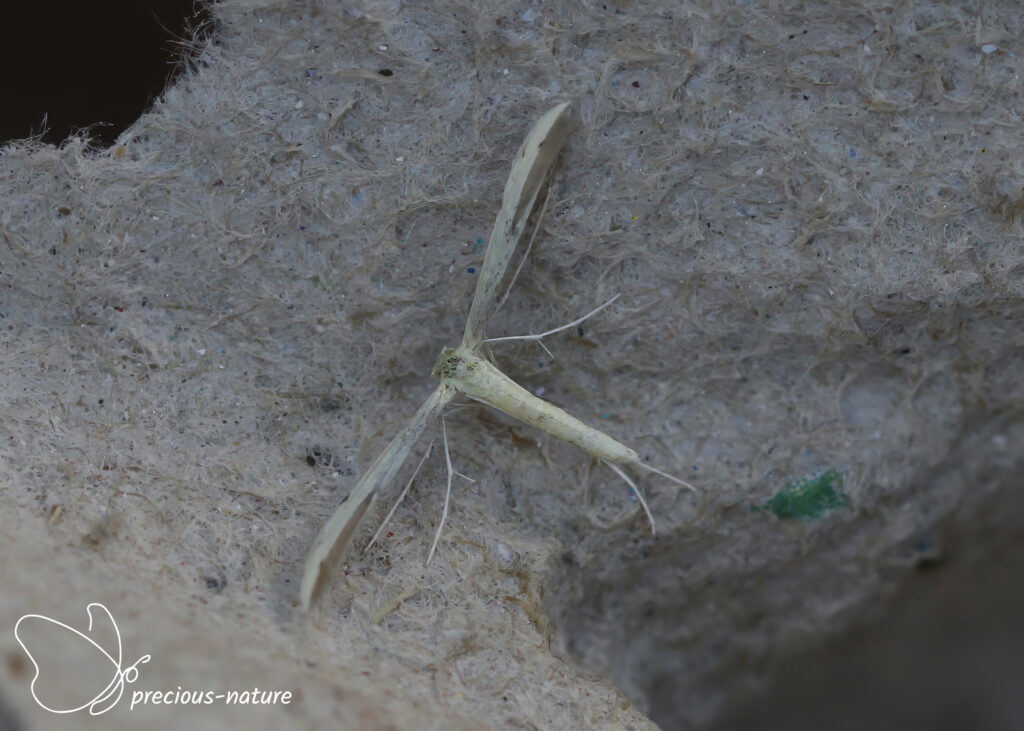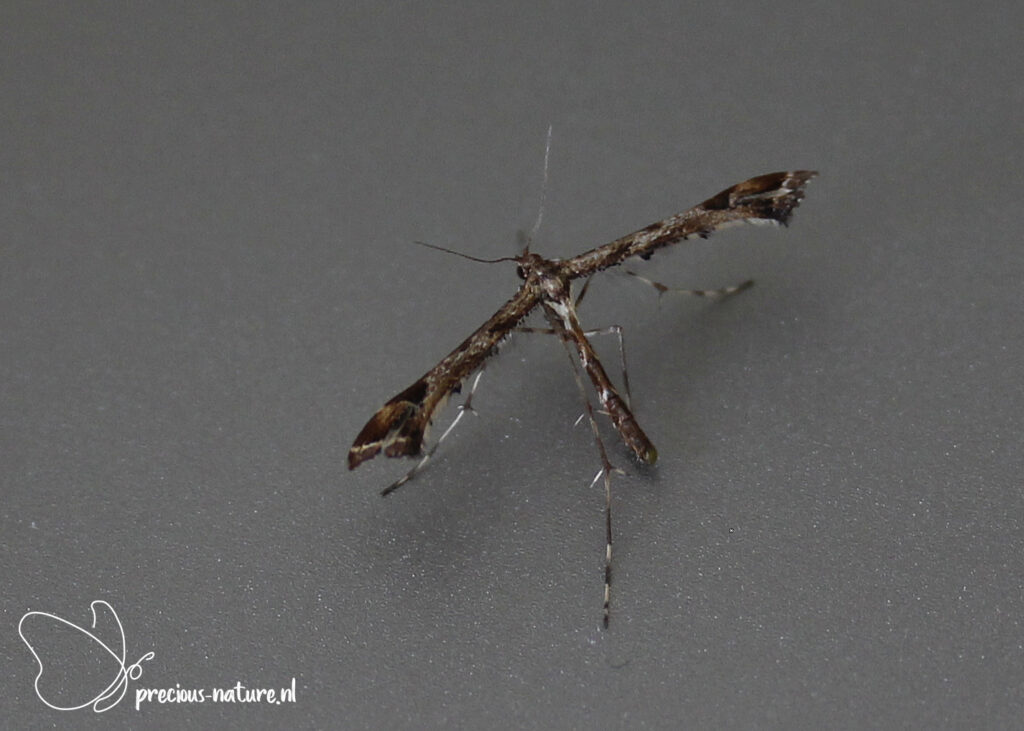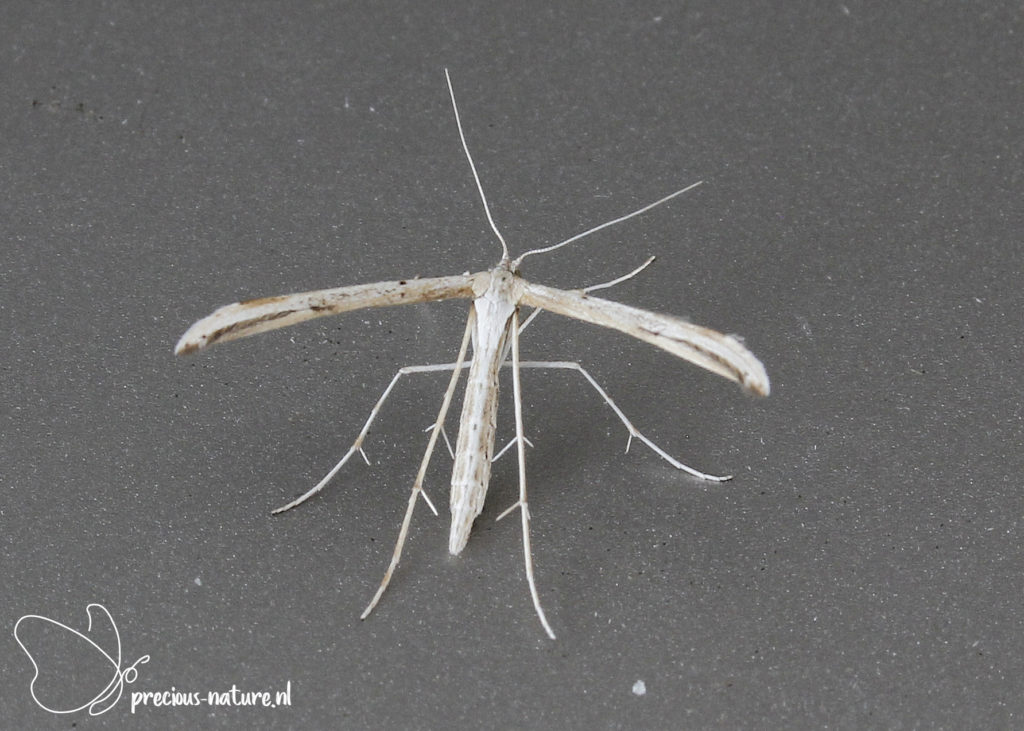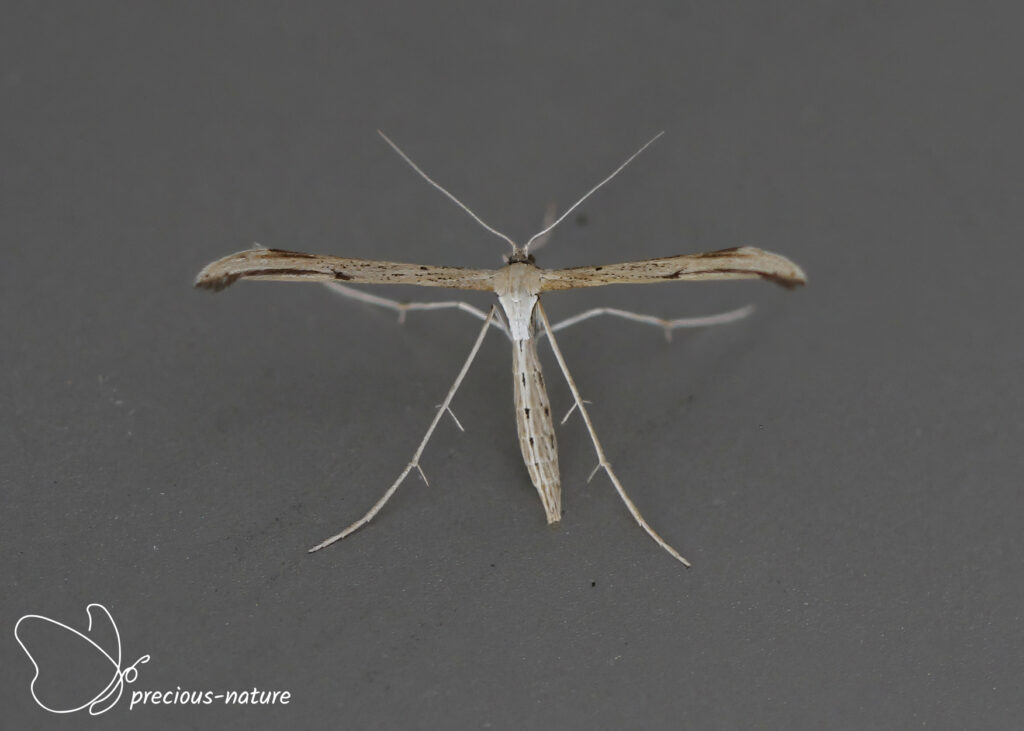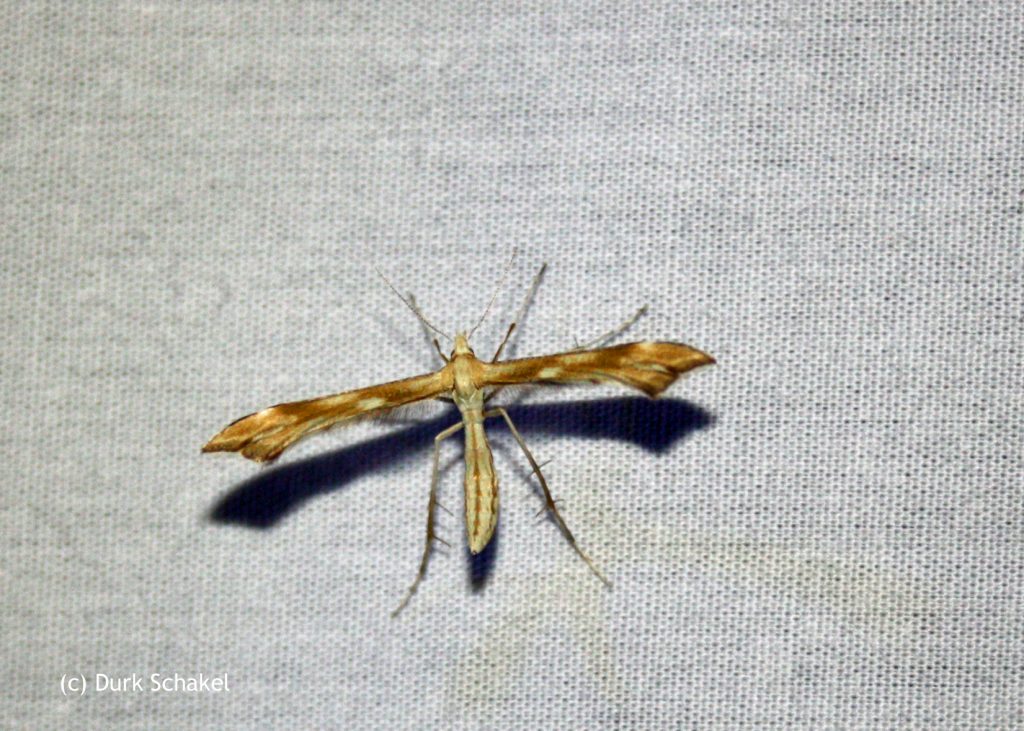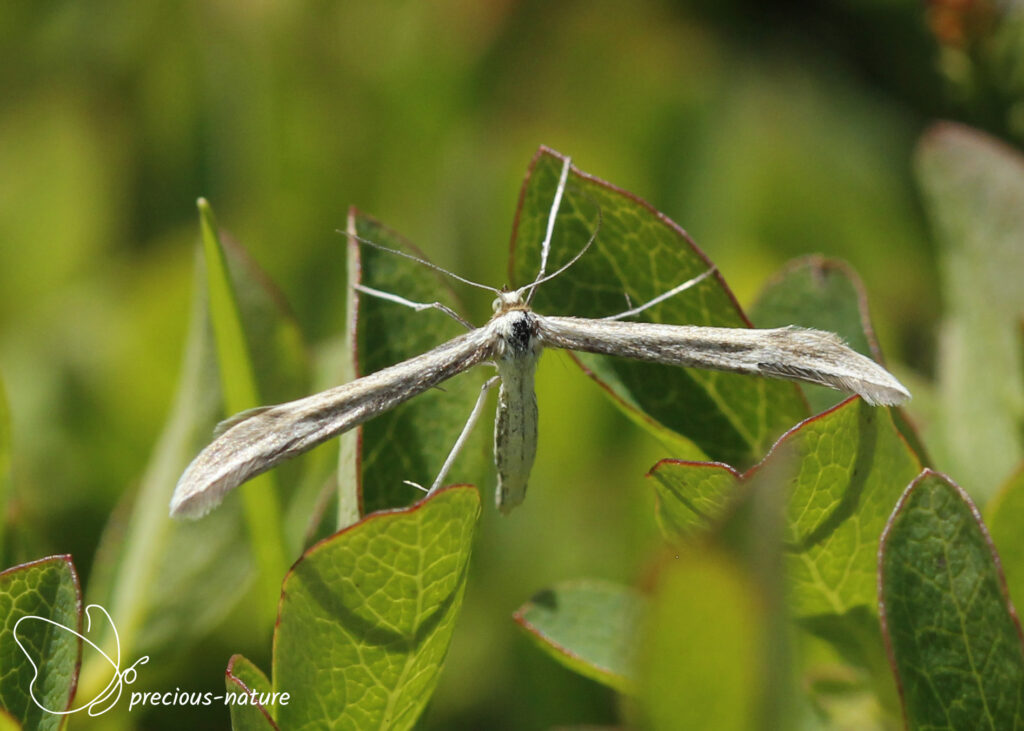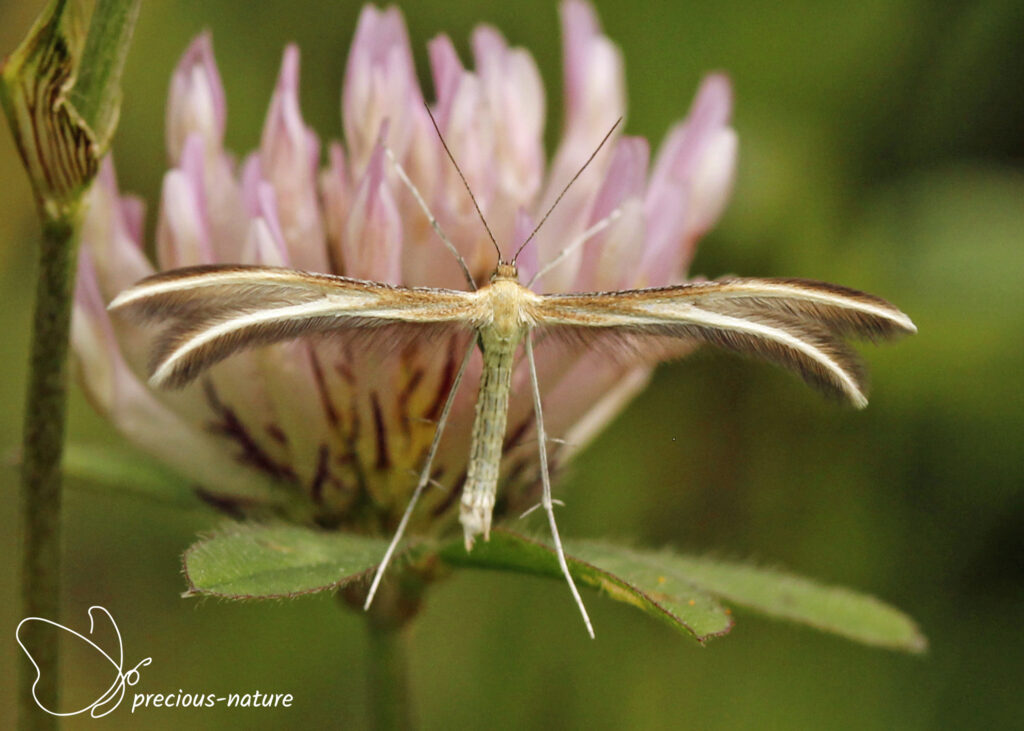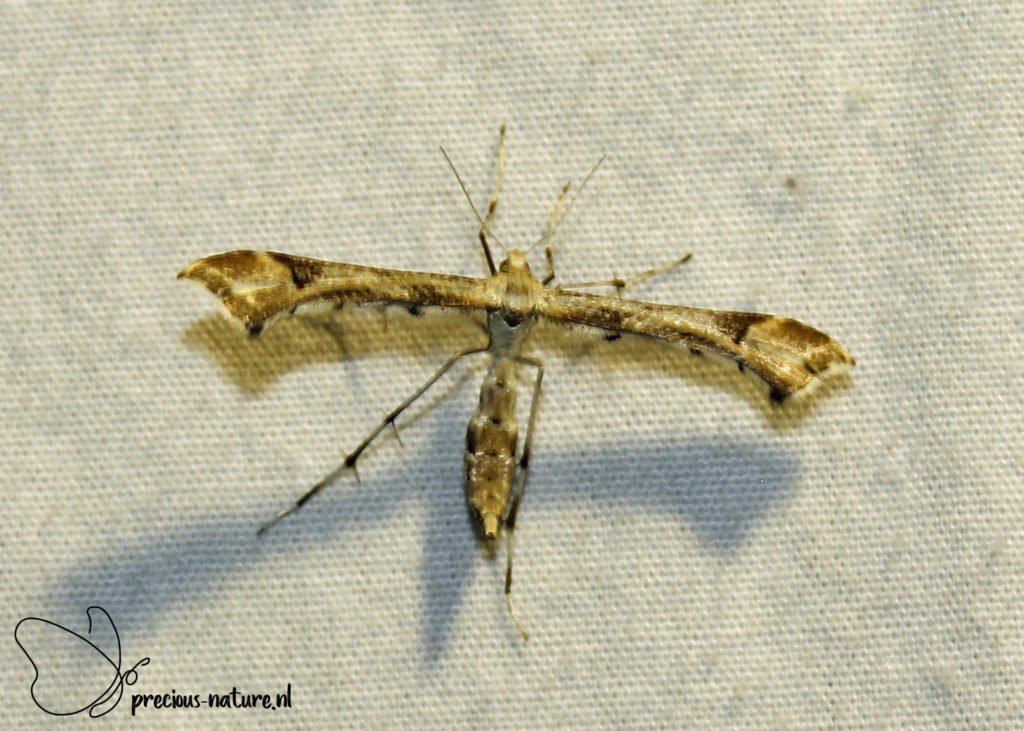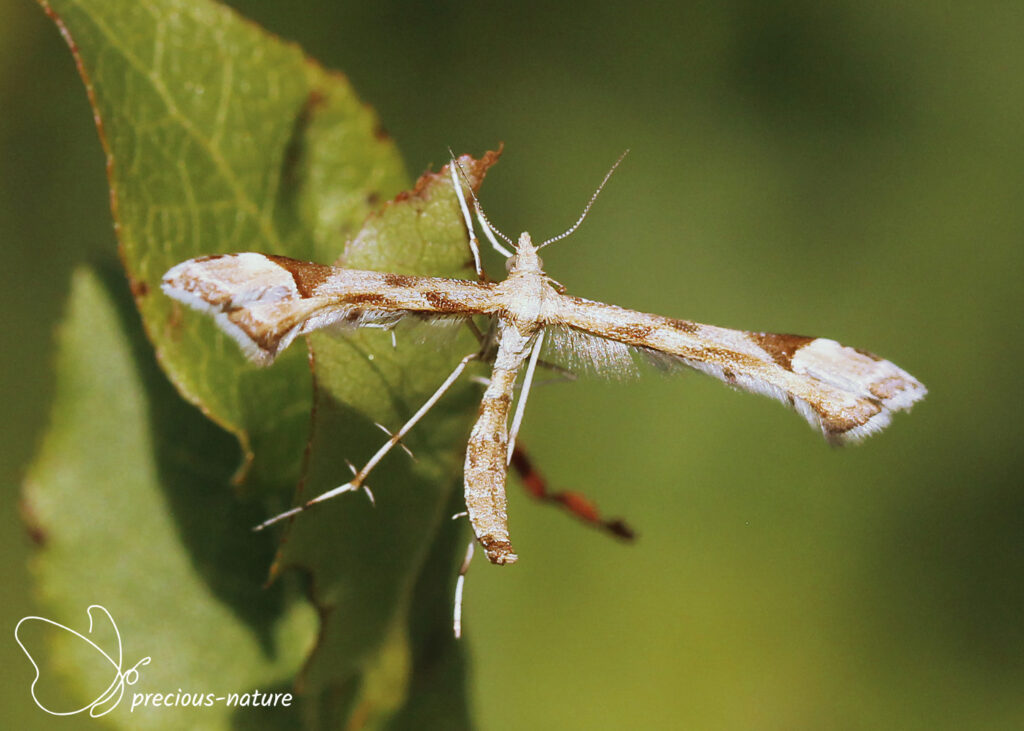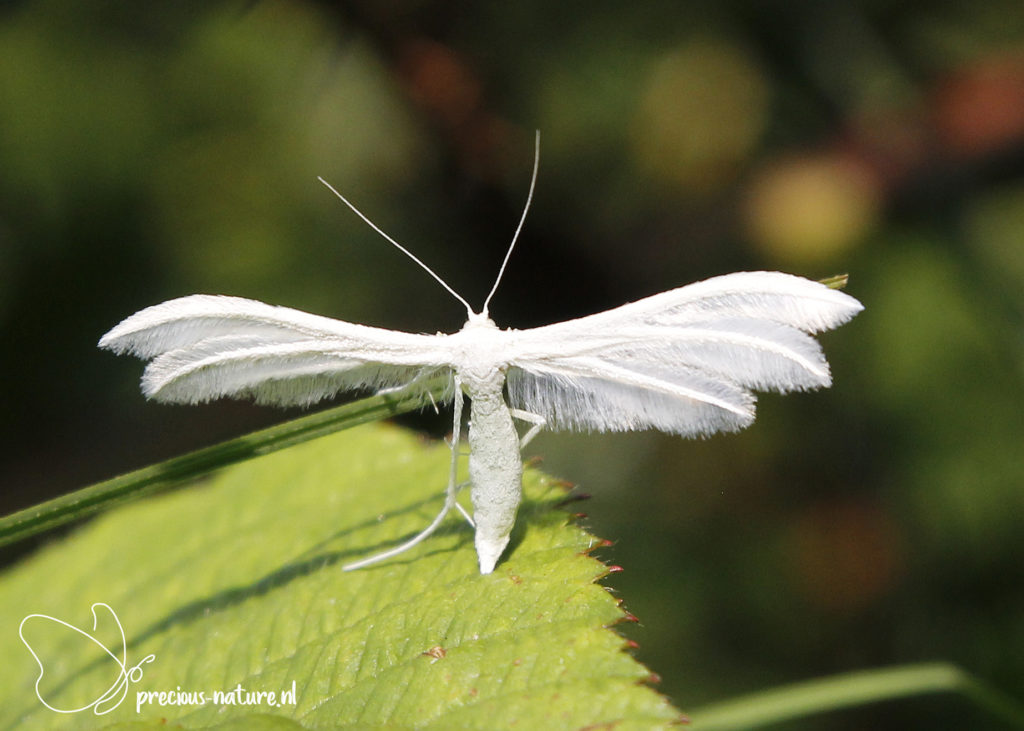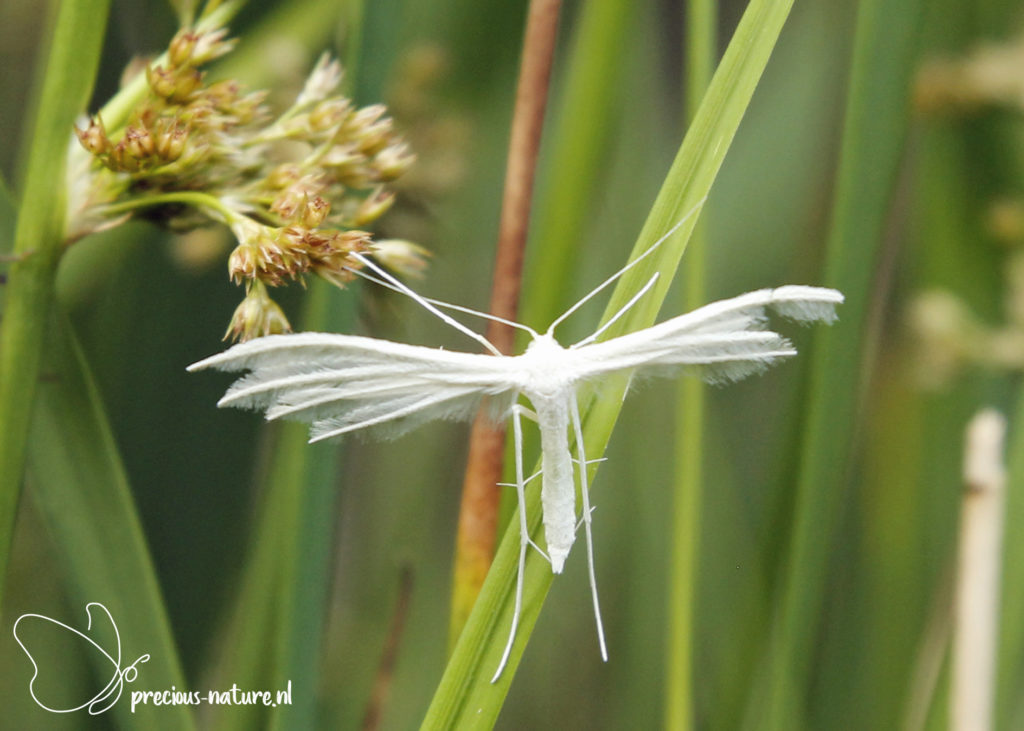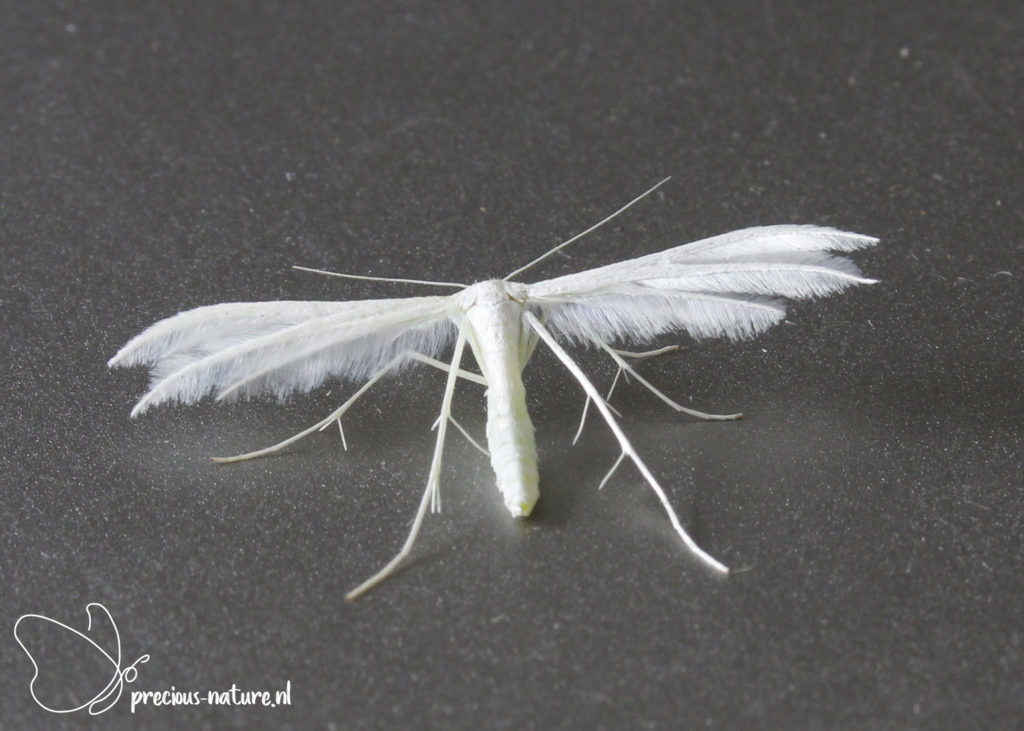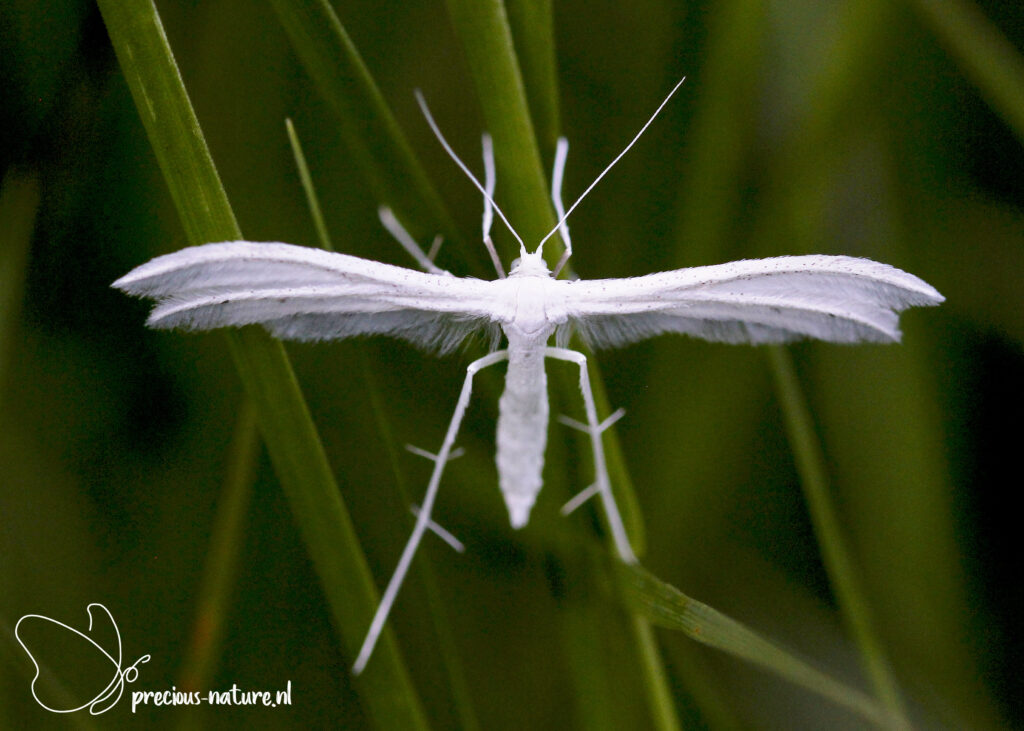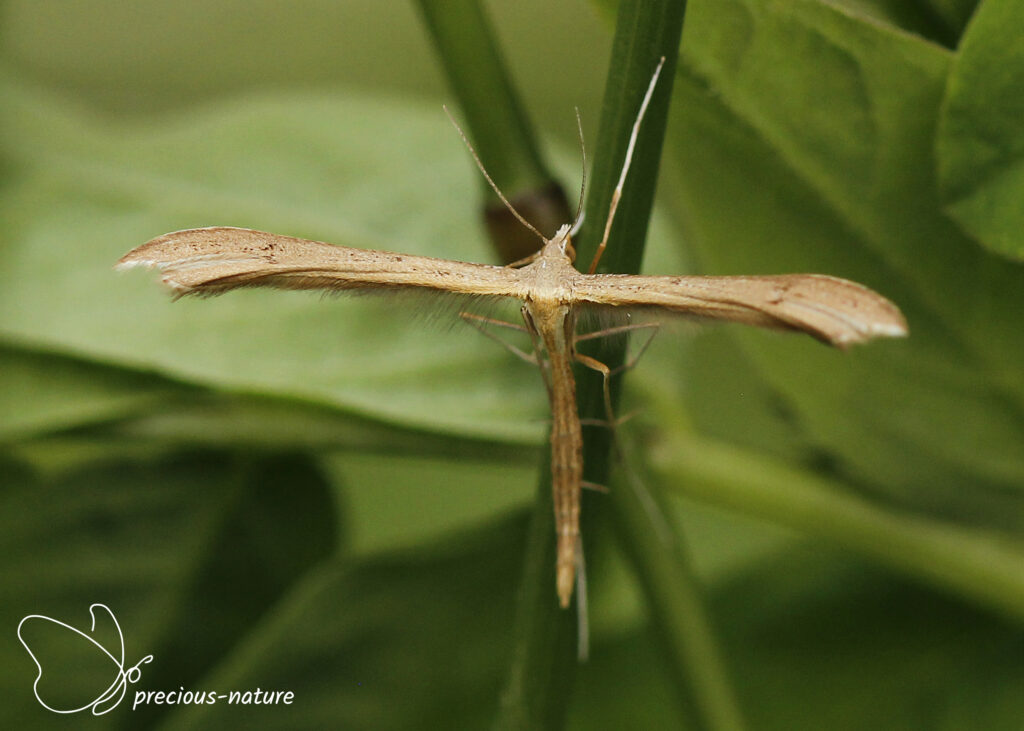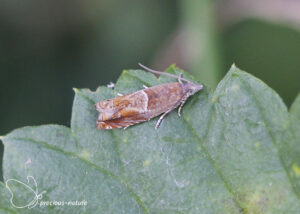Plume Moths (Pterophoridae) are special moths in terms of shape. They have a long and slender body, the legs are also long with conspicuous branching, and the wings are narrow, and together with the body in a resting position, they form a ‘T’. Their characteristic is a deeply split wing, creating three parts, each with wide fringes. They are night flyers and are dull in colour. They are often brown and grey with light and dark markings.
Subfamily: Pterophorinae
Genus: Adaina
Hemp-agrimony Plume – 2020 (NL)
(NCBI-index: 1.594217)
A fairly common plume moth is the Hemp-agrimony Plume (Adaina microdactyla). The forewing cleft is just past halfway and is pale yellow, sometimes yellow-white, pale brown, or pale grey. At the base of the cleft in the forewing is a brown spot, and on the costal lobe at the costa are two small brown spots. Although the moth is well attracted to light, during the day, you can keep an eye out for the feeding of the Hemp-agrimony. It is one of the smallest plume moths in Europe. The flying period spans two generations from May to the beginning of September, and the wingspan ranges from 13 to 17 mm. Host plant: Hemp-agrimony. Dutch name: Dwergvedermot. Frisian name: –
Flying period:

Subfamily: Pterophorinae
Genus: Amblyptilia
Beautiful Plume – 2018 (NL)
(NCBI-index: 2.560943)
Identifying plume moths is always a challenge. The Beautiful Plume (Amblyptilia acanthadactyla) is still fairly recognisable. The forewing is split from 2/3 and reddish-brown, lightly speckled. Just before the split of the wings, a dark triangle is visible close to the costa. The apex is slightly darker with a distinct light transverse streak. On the thorax, you can see two white V-shapes pointing towards the head. The part of the abdomen just in front of the wings is light-colored with a very thin, slightly dark streak. The flying period is from June to September, and the wingspan is 17-23 mm. Host plant: A Large range of plants. Dutch name: Scherphoekvedermot. Frisian name: –
Flying period:

Subfamily: Pterophorinae
Genus: Emmelina
Morning-glory Plume Moth – 2017 (NL)
(NCBI-index: 467774)
The Morning-glory Plume Moth (Emmelina monodactyla) is one of the common plume moths in the Netherlands. The wings are split, but that is difficult to see as it has rolled its wings closed when resting. The colour of the wing is pale brown, and along the length of the body is a lighter band with a row of dark dots. The flight time is in two generations from March to October, and the wingspan is 18-27 mm. Host plant: Bindweeds. Dutch name: Windevedermot. Frisian name: –
Flying period:

Subfamily: Pterophorinae
Genus: Gillmeria
Yarrow Plume – 2017 (NL)
(NCBI-index: 687094)
The Yarrow Plume (Gillmeria pallidactyla) has a brown band on the hind legs. The moth is brownish-white with a distinct dark spot on the forewing at the costa halfway down the wing. The flight period of this moth is from June to August, and the wingspan is 23-27 mm. Host plant: Tansy, Yarrow. Dutch name: Lichte zandvedermot. Frisian name: –
Flying period:

Subfamily: Pterophorinae
Genus: Hellinsia
Cleaver Plume Moth – 2024 (CH)
(NCBI-index: 1.869991)
Identifying plume moths remains difficult. It is essential to pay close attention to markings on the wings and the shape and pattern of the abdomen. The Cleaver Plume Moth (Hellinsia didactylites) has grey-white to cream-yellow wings. A thin dark stripe can be seen along the leading edge. Furthermore, the tips of the rear wing are dark-coloured. The abdomen is quite broad and flat, with a narrow brown stripe along its length. The Cleaver Plume Moth is mainly found on sandy soils. The flight period spans two generations, from May to October, and the wingspan ranges from 19 to 23 mm. Host plant: Narrowleaf Hawkseed. Dutch name: Roomkleurige vedermot. Frisian name: –
Flying period:

Subfamily: Pterophorinae
Genus: Merrifieldia
Thyme Plume – 2024 (CH)
(NCBI-index: 1.870077)
You must be lucky to encounter plume moths during the day. During my trip to Switzerland, I came across the Thyme Plume (Merrifieldia leucodactyla). The forewing of this plume moth is split into two parts up to the middle. Both parts run apart towards the wing tips and bend backwards. The rear half is pale yellow, and the front half is yellow-brown, with the leading edge dark brown. The fringe is strikingly dark-coloured. From the base, 1/3 of the antenna is alternately ringed dark brown and yellow. The flight period is one generation from June to August, and the wingspan is 18-25 mm. Host plant: Thyme, Broad Lungwort, Wild Marjoram. Dutch name: Tijmvedermot. Frisian name: –
Flying period:

Subfamily: Pterophorinae
Genus: Platyptilia
Triangle Plume – 2021 (NL)
(NCBI-index: 1.101034)
The most striking thing about the Triangle Plume (Platyptilia gonodactyla) is the dark brown triangle just above the cleft of the wing that starts at 3/4. Near the apex, close to the costa, a light brown spot can be seen, which sometimes extends to the dorsum. The thorax is conspicuously white at the top and passes through a narrowing into the wider brown abdomen. The flight period spans two generations, from May to August, and the wingspan ranges from 20 to 30 mm. Host plant: Colt’s-foot. Dutch name: Hoefbladvedermot. Frisian name: –
Flying period:

Subfamily: Pterophorinae
Genus: Platyptilia
Goldenrod Plume – 2024 (CH)
(NCBI-index: 1.594334)
The habitat of the Goldenrod Plume (Platyptilia calodactyla) is where the diversity of plants is higher, often in higher areas. This species is easily recognisable by the pale orange-brown with white checkered scales in the middle of the wing. The forewing is split from 3/4, and along the leading edge, just before the split, a striking dark brown triangular spot can be seen. The flight period is from June to August in one generation, and the wingspan is 18-24 mm. Host plant: Goldenrod, Shade Ragwort, Woodland Ragwort. Dutch name: Guldenroedevedermot. Frisian name: –
Flying period:

Subfamily: Pterophorinae
Genus: Pterophorus
White Plume Moth – 2017 (NL)
(NCBI-index: 1.572507)
The White Plume Moth (Pterophorus pentadactylus) is also called the Five-fingered Plume Moth. It is an all-white moth with wings that resemble five feathers on either side. The hindwing is split into three parts and the forewing into two parts. The flying period is from May to August in two generations, and the wingspan is 26-34 mm. Host plant: Bindweed. Dutch name: Sneeuwwitte vedermot. Frisian name: –
Flying period:

Subfamily: Pterophorinae
Genus: Stenoptilia
Brown Plume – 2024 (CH)
(NCBI-index: 1.594347)
The group of plume moths remains an interesting species, but some species are difficult to distinguish from each other. The Brown Plume (Stenoptilia pterodactyla) looks very similar to the Twin-spot Plume (Stenoptilia bipunctidactyla). Both species have two small dark spots, rarely fused into one spot, on the upperside of the wing where the wing splits into two lobes. The Brown Plume has reddish-brown to yellowish-brown wings and a white fringe. These characteristics are distinctive because the wings of the Twin-spot Plume are greyish brown, and the fringe is dark. The flight period spans one generation, from May to early August, and the wingspan ranges from 20 to 26 mm. Host plant: Common Speedwell. Dutch name: Ereprijsvedermot. Frisian name: –
Flying period:


